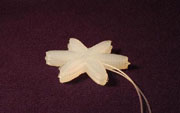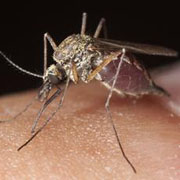-
(单词翻译:双击或拖选)
SCIENCE IN THE NEWS - A Soft Body, but the Mind of a Robot
SHIRLEY GRIFFITH: This is SCIENCE IN THE NEWS in VOA Special English. I'm Shirley Griffith.
STEVE EMBER: And I'm Steve Ember. Today, we tell about soft-bodied robots -- robots that can move more easily than those made of metal. We also tell about efforts to control the disease malaria1. And we tell about how being president of the United States can be good for your health.
(MUSIC)
SHIRLEY GRIFFITH: When many of us think of robots, we picture large, metal objects in the shape of humans, having difficulty moving around. But robots have come a long way. A team at Harvard University in Massachusetts recently developed a soft-bodied robot. The team based the design of its robot on sea creatures without hard shells or skeletons.
STEVE EMBER: The robotic device was made with soft materials called elastomers. It is about thirteen centimeters long and has four legs that can move separately. The movements are controlled by compressed air and can be operated from a computer.
George Whitesides led the Harvard researchers. The United States Department of Defense2 paid for the project.
 |
| An elastomeric gripper robot |
The robot itself took two months to develop. In tests, researchers have guided the robot under a plate of glass less than three centimeters high. The researchers say their invention can move at a speed of about thirteen meters an hour.
A report about the robot was published in November in the journal Proceedings3 of the National Academy of Sciences.
SHIRLEY GRIFFITH: Increasingly, soft robots are being developed for difficult jobs like moving through a battlefield or wreckage4 from a natural disaster. The robot can move across uneven5 surfaces including small rocks and wet dirt.
Earlier this year, scientists from Tufts University in Massachusetts developed another kind of soft robot made of silicone rubber. This robot is about ten centimeters long and shaped like a caterpillar6. It is able to roll up into a ball shape and move itself forward.
But researchers say there are difficulties in making these robots move. For one, they want to find a way for the robot to transport its own power source. They are also hoping to improve its speed.
(MUSIC)
STEVE EMBER: The World Health Organization says malaria was responsible for seven hundred eighty-one thousand deaths in two thousand nine. Most of those deaths were in children in Africa. Worldwide there were two hundred twenty-five million cases of the disease.
Both of these numbers represent improvements. In two thousand there were an estimated two hundred thirty-three million cases of malaria and almost a million deaths.
Malaria remains7 a major problem in Africa, but there have been some successes. Deaths in Rwanda, for example, have been reduced by sixty percent.
SHIRLEY GRIFFITH: The main way for communities to control malaria is by controlling mosquitoes. The disease comes from a parasite8 spread through the bite of infected mosquitoes.
In a recent study, researchers in West Africa showed that an insecticide spray can greatly reduce malaria transmission. Researchers at the Center de Recherche9 Entomologique de Cotonou tested a chemical called bendiocarb. They tested it with indoor spraying at sites throughout Benin.
The study found there were fewer mosquito bites in homes sprayed with bendiocarb. More importantly, none of the three hundred fifty-thousand people who lived there got malaria-infected mosquito bites during the test.
STEVE EMBER:Malaria control efforts currently depend on things like chemically treated bed nets and spraying against mosquitoes. But scientists keep trying to find other ways to prevent the disease.
 |
| Mosquito feeding from human finger |
There are still no vaccines11 to prevent malaria. But a number of vaccines remain under development. Most contain genetically12 engineered versions of a few proteins from the Plasmodium parasite.
Plasmodium is the organism that causes malaria. Those modified proteins are designed to get the body's defenses to launch an immune response against the Plasmodium. But the parasite contains thousands of proteins.
SHIRLEY GRIFFITH: Another experimental vaccine10 includes a deactivated13 version of the entire parasite. Robert Seder works at the National Institute of Allergy15 and Infectious Diseases, near Washington.
ROBERT SEDER: "So instead of picking out one or two or three genes16, you have the potential for what we call breadth -- generating an immune response that would be broad rather than narrower. And so that would be a good thing."
Radiation is used to weaken the parasite so it cannot make people sick or get spread by a mosquito. To make the vaccine, scientists use the parasite at a time in its growth when the organism is called a sporozoite.
This idea has been known since the nineteen sixties. But Mr. Seder says a discovery by a researcher at a vaccine company cleared the way for progress.
ROBERT SEDER: "The major breakthrough here was that my collaborator17, Stephen Hoffman at Sanaria, developed a method where he could isolate18 the sporozoites and purify them so that they could administer it as a vaccine to humans. And no one thought that that was possible."
But no one knew either if the weakened sporozoites would activate14 the immune system to protect against malaria. So researchers tested it on volunteers and found that it was safe -- there were only minor19 side effects. But it was not very effective. Only two out of forty-four volunteers were protected when bitten by malaria-infected mosquitoes.
STEVE EMBER: To find out why, the researchers tested the vaccine on laboratory animals. They decided20 that the problem was the way the vaccine had been given to the volunteers. It was injected into the skin, to simulate the bite of a mosquito. Mr. Seder says it would have been more effective if it had been given directly into the blood.
For now, more testing is needed. A report on the testing appeared in Science magazine.
(MUSIC)
SHIRLEY GRIFFITH: Finally, many Americans say the hardest job in the world is being president of the United States. The man, or woman, who lives and works in the White House must be able to deal with problems twenty-four hours a day, seven days a week. Even on holidays or in the middle of the night, the president may have to make decisions that affect both people in this country and the rest of the world.
That is why some news media tell about changes in a president's personal appearance during his time in office. Last August, President Obama celebrated21 his fiftieth birthday. Some pictures showed him as a man with grayer hair and more lines on his face than when he first took office. And that got researcher S. Jay Olshansky to thinking. He studies aging at the University of Illinois at Chicago.
STEVE EMBER: Doctors nearly always say that high levels of stress are bad for your health. So people would expect a president's life to be shorter than average. Some people even say that being president could cause a person to age two times as fast as normal. But Professor Olshansky was not persuaded. So he examined the lives of the thirty-four American presidents who died of natural causes. He found that twenty-three of them lived longer than most people born at the same time.
The average age of those thirty-four presidents when they died was seventy-three. If they had aged22 two times as fast as normal, they should have lived to be only sixty-eight point one years old. The professor also found that the first eight presidents lived an average of seventy-nine point eight years. At that time, modern medicines had not been invented, and most men lived only about forty years.
 |
| Former U.S. President Gerald Ford23 and his wife Betty. President Ford lived to be ninety-three, older than any other president. |
Four American presidents lived past ninety. John Adams, Herbert Hoover, and Ronald Reagan each lived ninety or more years. But Gerald Ford lived longer than any other president. He was ninety-three and a half when he died in two thousand six.
SHIRLEY GRIFFITH: Professor Olshansky says gray hair, hair loss and other changes are part of aging and may result from something in our genes. So presidents are no different from the rest of us. But the researcher thinks there are three reasons they outlive other people. Most presidents are well-educated. Many are wealthy when compared to other Americans. And they have the best medical care possible. They know how to stay healthy, and have the best doctors. As a result, they can afford to live a healthy life long after they leave the White House.
Professor Olshansky says, "It is a classic illustration of the benefits of socioeconomic status." His study was published last month in the Journal of the American Medical Association.
(MUSIC)
STEVE EMBER: This SCIENCE IN THE NEWS was written by Brianna Blake, Christopher Cruise and Jim Tedder24. I'm Steve Ember.
SHIRLEY GRIFFITH: And I'm Shirley Griffith. Join us again next week for more news about science in Special English on the Voice of America.
 收听单词发音
收听单词发音
1
malaria

|
|
| n.疟疾 | |
参考例句: |
|
|
|
2
defense

|
|
| n.防御,保卫;[pl.]防务工事;辩护,答辩 | |
参考例句: |
|
|
|
3
proceedings

|
|
| n.进程,过程,议程;诉讼(程序);公报 | |
参考例句: |
|
|
|
4
wreckage

|
|
| n.(失事飞机等的)残骸,破坏,毁坏 | |
参考例句: |
|
|
|
5
uneven

|
|
| adj.不平坦的,不规则的,不均匀的 | |
参考例句: |
|
|
|
6
caterpillar

|
|
| n.毛虫,蝴蝶的幼虫 | |
参考例句: |
|
|
|
7
remains

|
|
| n.剩余物,残留物;遗体,遗迹 | |
参考例句: |
|
|
|
8
parasite

|
|
| n.寄生虫;寄生菌;食客 | |
参考例句: |
|
|
|
9
recherche

|
|
| adj.精选的;罕有的 | |
参考例句: |
|
|
|
10
vaccine

|
|
| n.牛痘苗,疫苗;adj.牛痘的,疫苗的 | |
参考例句: |
|
|
|
11
vaccines

|
|
| 疫苗,痘苗( vaccine的名词复数 ) | |
参考例句: |
|
|
|
12
genetically

|
|
| adv.遗传上 | |
参考例句: |
|
|
|
13
deactivated

|
|
| v.解除动员( deactivate的过去式和过去分词 );使无效;复员;使不活动 | |
参考例句: |
|
|
|
14
activate

|
|
| vt.使活动起来,使开始起作用 | |
参考例句: |
|
|
|
15
allergy

|
|
| n.(因食物、药物等而引起的)过敏症 | |
参考例句: |
|
|
|
16
genes

|
|
| n.基因( gene的名词复数 ) | |
参考例句: |
|
|
|
17
collaborator

|
|
| n.合作者,协作者 | |
参考例句: |
|
|
|
18
isolate

|
|
| vt.使孤立,隔离 | |
参考例句: |
|
|
|
19
minor

|
|
| adj.较小(少)的,较次要的;n.辅修学科;vi.辅修 | |
参考例句: |
|
|
|
20
decided

|
|
| adj.决定了的,坚决的;明显的,明确的 | |
参考例句: |
|
|
|
21
celebrated

|
|
| adj.有名的,声誉卓著的 | |
参考例句: |
|
|
|
22
aged

|
|
| adj.年老的,陈年的 | |
参考例句: |
|
|
|
23
Ford

|
|
| n.浅滩,水浅可涉处;v.涉水,涉过 | |
参考例句: |
|
|
|
24
tedder

|
|
| n.(干草)翻晒者,翻晒机 | |
参考例句: |
|
|
|















